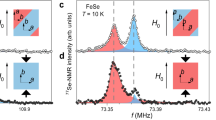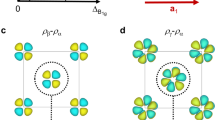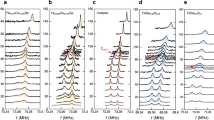Abstract
A fundamental and unconventional characteristic of superconductivity in iron-based materials is that it occurs in the vicinity of two other instabilities. In addition to a tendency towards magnetic order, these Fe-based systems have a propensity for nematic ordering: a lowering of the rotational symmetry while time-reversal invariance is preserved. Setting the stage for superconductivity, it is heavily debated whether the nematic symmetry breaking is driven by lattice, orbital or spin degrees of freedom. Here, we report a very clear splitting of NMR resonance lines in FeSe at Tnem = 91 K, far above the superconducting Tc of 9.3 K. The splitting occurs for magnetic fields perpendicular to the Fe planes and has the temperature dependence of a Landau-type order parameter. Spin–lattice relaxation rates are not affected at Tnem, which unequivocally establishes orbital degrees of freedom as driving the nematic order. We demonstrate that superconductivity competes with the emerging nematicity.
This is a preview of subscription content, access via your institution
Access options
Subscribe to this journal
Receive 12 print issues and online access
$259.00 per year
only $21.58 per issue
Buy this article
- Purchase on Springer Link
- Instant access to full article PDF
Prices may be subject to local taxes which are calculated during checkout




Similar content being viewed by others
References
Yi, M. et al. Symmetry-breaking orbital anisotropy observed for detwinned Ba(Fe1−xCox)2As2 above the spin density wave transition. Proc. Natl Acad. Sci. USA 108, 6878–6883 (2011).
Chu, J-H., Kuo, H-H., Analytis, J. G. & Fisher, I. R. Divergent nematic susceptibility in an iron arsenide superconductor. Science 337, 710–712 (2012).
Kasahara, S. et al. Contrasts in electron correlations and inelastic scattering between LiFeP and LiFeAs revealed by charge transport. Phys. Rev. B 85, 060503 (2012).
Böhmer, A. E. et al. Nematic susceptibility of hole-doped and electron-doped BaFe2As2 iron-based superconductors from shear modulus measurements. Phys. Rev. Lett. 112, 047001 (2014).
McQueen, T. M. et al. Tetragonal-to-orthorhombic structural phase transition at 90 K in the superconductor Fe1.01Se. Phys. Rev. Lett. 103, 057002 (2009).
Margadonna, S. et al. Crystal structure of the new FeSe1−x superconductor. Chem. Commun. 5607–5609 (2008).
Fu, M. et al. NMR search for the spin nematic state in a LaFeAsO single crystal. Phys. Rev. Lett. 109, 247001 (2012).
Fang, C., Yao, H., Tsai, W-F., Hu, J. & Kivelson, S. A. Theory of electron nematic order in LaFeAsO. Phys. Rev. B 77, 224509 (2008).
Xu, C. & Sachdev, S. The new iron age. Nature Phys. 4, 898–900 (2008).
Fradkin, E. & Kivelson, S. A. Electron nematic phases proliferate. Science 327, 155–156 (2010).
Krüger, F., Kumar, S., Zaanen, J. & van den Brink, J. Spin-orbital frustrations and anomalous metallic state in iron-pnictide superconductors. Phys. Rev. B 79, 054504 (2009).
Lv, W., Wu, J. & Phillips, P. Orbital ordering induces structural phase transition and the resistivity anomaly in iron pnictides. Phys. Rev. B 80, 224506 (2009).
Lee, C-C., Yin, W-G. & Ku, W. Ferro-orbital order and strong magnetic anisotropy in the parent compounds of iron-pnictide superconductors. Phys. Rev. Lett. 103, 267001 (2009).
Daghofer, M. et al. Orbital-weight redistribution triggered by spin order in the pnictides. Phys. Rev. B 81, 180514 (2010).
Chen, C-C. et al. Orbital order and spontaneous orthorhombicity in iron pnictides. Phys. Rev. B 82, 100504 (2010).
Fernandes, R. M., Chubukov, A. V. & Schmalian, J. What drives nematic order in iron-based superconductors? Nature Phys. 10, 97–104 (2014).
Paglione, J. & Greene, R. L. High-temperature superconductivity in iron-based materials. Nature Phys. 6, 645–658 (2010).
Hsu, F-C. et al. Superconductivity in the PbO-type structure α-FeSe. Proc. Natl Acad. Sci. USA 105, 14262–14264 (2008).
Wang, Q-Y. et al. Interface-induced high-temperature superconductivity in single unit-cell FeSe films on SrTiO3 . Chin. Phys. Lett. 29, 037402 (2012).
Xiang, Y-Y., Wang, F., Wang, D., Wang, Q-H. & Lee, D-H. High-temperature superconductivity at the FeSe/SrTiO3 interface. Phys. Rev. B 86, 134508 (2012).
Tan, S. et al. Interface-induced superconductivity and strain-dependent spin density waves in FeSe/SrTiO3 thin films. Nature Mater. 12, 634–640 (2013).
He, S. et al. Phase diagram and electronic indication of high-temperature superconductivity at 65 K in single-layer FeSe films. Nature Mater. 12, 605–610 (2013).
Zhang, W-H. et al. Direct observation of high-temperature superconductivity in one-unit-cell FeSe films. Chin. Phys. Lett. 31, 017401 (2014).
Ge, J-F. et al. Superconductivity in single-layer films of FeSe with a transition temperature above 100 K. Preprint at http://arxiv.org/abs/1406.3435 (2014).
Böhmer, A. E. et al. Lack of coupling between superconductivity and orthorhombic distortion in stoichiometric single-crystalline FeSe. Phys. Rev. B 87, 180505 (2013).
Imai, T., Ahilan, K., Ning, F. L., McQueen, T. M. & Cava, R. J. Why does undoped FeSe become a high-Tc superconductor under pressure? Phys. Rev. Lett. 102, 177005 (2009).
Medvedev, S. et al. Electronic and magnetic phase diagram of β-Fe1.01Se with superconductivity at 36.7 K under pressure. Nature Mater. 8, 630–633 (2009).
Korshunov, M. M., Eremin, I., Efremov, D. V., Maslov, D. L. & Chubukov, A. V. Nonanalytic spin susceptibility of a fermi liquid: The case of Fe-based pnictides. Phys. Rev. Lett. 102, 236403 (2009).
Song, C-L. et al. Direct observation of nodes and twofold symmetry in FeSe superconductor. Science 332, 1410–1413 (2011).
Chareev, D. et al. Single crystal growth and characterization of tetragonal FeSe1−x superconductors. Cryst. Eng. Commun. 15, 1989–1993 (2013).
Acknowledgements
The authors thank G. Prando and H-J. Grafe for discussion. This work has been supported by the Deutsche Forschungsgemeinschaft (Germany) through DFG Research Grants BA 4927/1-1 and the Priority Program SPP 1458. Financial support through the DFG Research Training Group GRK 1621 is gratefully acknowledged. The work at POSTECH was supported by the National Research Foundation (NRF) through the Mid-Career Researcher Program (No. 2012-013838), SRC Center for Topological Matter (No. 2011-0030046), and the Max Planck POSTECH/KOREA Research Initiative Program (No. 2011-0031558), and also by the Institute of Basic Science (IBS) through the Center for Artificial Low Dimensional Electronic Systems.
Author information
Authors and Affiliations
Contributions
S-H.B. performed the main NMR measurements, analysed data, and participated in writing of the manuscript; J.M.O. and J.S.K. synthesized the sample; D.V.E. and J.v.d.B. provided theoretical support and participated in writing of the manuscript; B.B. supervised and guided the study and participated in the writing of the manuscript. All authors discussed the results and commented on the manuscript.
Corresponding author
Ethics declarations
Competing interests
The authors declare no competing financial interests.
Supplementary information
Supplementary Information
Supplementary Information (PDF 383 kb)
Rights and permissions
About this article
Cite this article
Baek, SH., Efremov, D., Ok, J. et al. Orbital-driven nematicity in FeSe. Nature Mater 14, 210–214 (2015). https://doi.org/10.1038/nmat4138
Received:
Accepted:
Published:
Issue Date:
DOI: https://doi.org/10.1038/nmat4138
This article is cited by
-
Nanoscale inhomogeneity and the evolution of correlation strength in FeSe\(_{1-x}\)S\(_x\)
Nano Convergence (2023)
-
Spin fluctuations from Bogoliubov Fermi surfaces in the superconducting state of S-substituted FeSe
Communications Physics (2023)
-
Spontaneous orbital polarization in the nematic phase of FeSe
Nature Materials (2023)
-
Nematic fluctuations in an orbital selective superconductor Fe1+yTe1−xSex
Communications Physics (2023)
-
Possible star-of-David pattern charge density wave with additional modulation in the kagome superconductor CsV3Sb5
npj Quantum Materials (2022)



